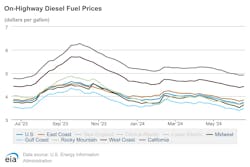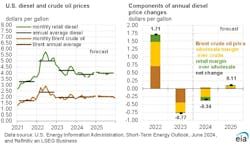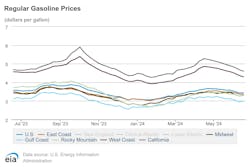After nearly 10 straight weeks of falling diesel prices, government trackers found the national U.S. on-highway diesel fuel price average increased 7 cents to $3.735 per gallon this week. The U.S. Energy Information Administration noted June 17 that the average pump prices are still 8 cents cheaper than this time last year. The general rise in weekly diesel prices is reflected across nearly all regions of the country.
Regional diesel price increases ranged from less than a cent to 10 cents this week. The only place costs fell was the New England sub-region, where diesel dropped less than a cent to $4.085 per gallon. Otherwise, prices rose less than a cent in California to $4.915, 2 cents in the Central Atlantic sub-region to $4.050, and 3 cents up to $3.682 per gallon in the Rocky Mountain Region.
Increasing diesel costs hit the Midwest the hardest, where prices rose 10 cents to $3.621 per gallon. The Gulf Coast also saw its prices increase an average of 8 cents to $3.472, and the West Coast without California jumped up by 7 cents to $3.984.
Interestingly, despite these various increases, almost every region’s current diesel costs are lower than this time last year, save for California, where prices are 14 cents higher than in 2023. California is the most expensive place to buy diesel at $4.915 per gallon, while the Gulf Coast is still the cheapest at $3.472.
For comparison, the AAA motor club’s current diesel average is $3.771, which is 4 cents more expensive than the EIA’s reckoning and 1 cent cheaper than last week. Meanwhile, the AAA tracker's diesel price at this time last year was $3.892, 12 cents more expensive than the present.
See also: As temps heat up, diesel prices keep dropping
For more context on the nation’s diesel fuel, the EIA released its most recent Short-Term Energy Outlook. According to the report, the country’s crude oil production, which typically takes up the bulk of monthly fuel price allocations, grew 2% from 2023 to an annual average of 13.2 million barrels per day (b/d) in 2024. The organization anticipates 4% growth in 2025 to reach 13.7 million b/d. As for current and future pricing, the EIA logged current monthly diesel retail prices are meeting or just above the average price. However, it expects prices to dip below the average through the latter half of 2024 and then rise again heading into 2025.
Average gas price reaches $3.44 per gallon
While diesel costs increased overall, the EIA found that gas prices both rose and fell over the past week. As of June 18, the nationwide gas average is $3.44 per gallon, a price less than a cent higher than last week and 14 cents lower than last year. For the rest of the country, prices shifted by less than a cent up to 8 cents.
Prices dropped 1 cent on the East Coast to $3.357 per gallon, while the West Coast overall and the West Coast without California all dropped 7 cents to $4.293 and $3.958 per gallon, respectively. Meanwhile, California alone fell 8 cents to $4.599.
Meanwhile, prices rose 4 cents on the Gulf Coast to $2.992, 5 cents in the Midwest area to $3.315, and 6 cents in the Rocky Mountain region to $3.330 per gallon. Considering these numbers, the Gulf Coast is the cheapest place for gas at $2.992 per gallon, while California is the most expensive at $4.599.
The motor club clocked its current gas prices at $3.447 per gallon, with less than a cent of change between this week and the last but 13 cents cheaper than last year’s gas average of $3.577. According to a press release by the organization, the growing supply of gas with falling demand could be a cause of the rising prices.
“Gasoline demand has trailed 2023 for most of this year, and analysts believe economic uncertainty may suppress demand this summer,” said Andrew Gross, AAA spokesperson. “So, is the typical robust summer driving season a thing of the past? Or is gas demand just taking longer to pick up steam? We may not know until autumn.”
This article was originally published on FleetOwner.com.








